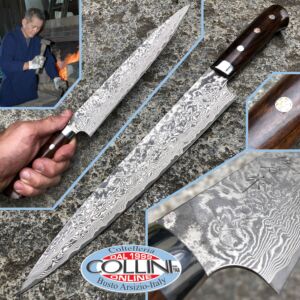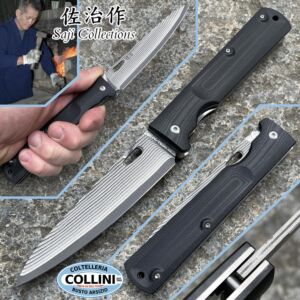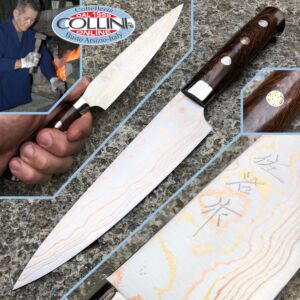Saji Takeshi
Takeshi Saji è nato nel 1948 a Takefu (prefettura di Fukui), una città situata all'incirca nel centro del Giappone e nel cuore di una zona da secoli votata alla produzione di lame. Il suo laboratorio è ancora lì, costruito intorno al forno grazie al quale, ormai da parecchi anni, Takeshi Saji forgia l'acciaio (soprattutto damasco) con cui realizza vari modelli di coltelli tradizionali giapponesi. La scelta dei materiali per le finiture (prevalentemente naturali), le linee essenziali - evocatrici dell'utilizzo - e gli accostamenti cromatici di raro impatto rendono le sue realizzazioni uniche e inconfondibili nel panorama della coltelleria mondiale e, in patria, gli sono valse il prestigioso titolo di Maestro.
La Coltelleria Collini di Busto Arsizio è distributore per l'Italia dei coltelli artigianali Takeshi Saji
-
Takeshi Saji - Bunka Knife 180mm in deer horn - VG-10 32 layers - vegetable kitchen knife
Takeshi Saji was born in 1948 in Takefu (Fukui prefecture), a city located roughly in the center of Japan and in the heart of an area for centuries devoted to the production of blades. His workshop is still there, built around the oven thanks to which, for several years now, Takeshi Saji has been forging steel (especially damascus) with which he makes various models of traditional Japanese knives. The choice of materials for the finishes (mainly natural), the essential lines - evocative of use - and the chromatic combinations of rare impact make his creations unique and unmistakable in the panorama of world cutlery and, at home, they have earned him the prestigious title of Maestro.
Intended use: vegetable knife
Type of production: Artisan
Production Lama: Japan
Blade: Hand forged, laminated damascus with 32-layer VG10 steel edge
Handle: in deer horn
Blade length: 180mm.
Blade thickness: 2.5mm.
Total length: 305mm.
Weight: 236g.
Packaging: Cardboard box
Notes: the knife is entirely handmade by Takeshi SajUse and maintenance
- Do not cut bones or frozen. The blade can chip or break.
- Hand wash with warm water and towel dry.
- Use stones for sharpening and maintenance of the blade.TS-BUN-H -
Takeshi Saji - Nakiri Knife 170mm in corno di cervo - VG-10 a 32 strati - coltello cucina verdure
Takeshi Saji was born in 1948 in Takefu (Fukui prefecture), a city located roughly in the center of Japan and in the heart of an area for centuries devoted to the production of blades. His workshop is still there, built around the oven thanks to which, for several years now, Takeshi Saji has been forging steel (especially damascus) with which he makes various models of traditional Japanese knives. The choice of materials for the finishes (mainly natural), the essential lines - evocative of use - and the chromatic combinations of rare impact make his creations unique and unmistakable in the panorama of world cutlery and, at home, they have earned him the prestigious title of Maestro.
Intended use: vegetable knife
Type of production: Artisan
Production Lama: Japan
Blade: Hand forged, laminated damascus with 32-layer VG10 steel edge
Handle: in deer horn
Blade length: 170mm.
Blade thickness: 2.5mm.
Total length: 300mm.
Weight: 260g.
Packaging: Cardboard box
Notes: the knife is entirely handmade by Takeshi SajUse and maintenance
- Do not cut bones or frozen. The blade can chip or break.
- Hand wash with warm water and towel dry.
- Use stones for sharpening and maintenance of the blade.TS-NAK-H -
Takeshi Saji - Sujihiki Knife 240mm with Desert Ironwood Handle - SPG2 Damascus - kitchen knife
Takeshi Saji was born in 1948 in Takefu (Fukui prefecture), a city located roughly in the center of Japan and in the heart of an area for centuries devoted to the production of blades. His workshop is still there, built around the oven thanks to which, for several years now, Takeshi Saji has been forging steel (especially damascus) with which he makes various models of traditional Japanese knives. The choice of materials for the finishes (mainly natural), the essential lines - evocative of use - and the chromatic combinations of rare impact make his creations unique and unmistakable in the panorama of world cutlery and, at home, they have earned him the prestigious title of Maestro.
Intended use: kitchen knife, meat, fish
Type of production: Artisan
Production Lama: Japan
Blade: Hand forged, laminated damascus with SPG2 sintered steel edge (63 hrc)
Handle: Desert Ironwood
Blade length: 235mm.
Blade thickness: 2.5mm.
Total length: 365mm.
Weight: 200g.
Packaging: Wooden box
Notes: the knife is entirely handmade by Takeshi SajUse and maintenance
- Do not cut bones or frozen. The blade can chip or break.
- Hand wash with warm water and towel dry.
- Use stones for sharpening and maintenance of the bladeTS-SUJ -
Takeshi Saji - Black Damascus Steak knife - SPG2 Damascus and Micarta - handmade knife
Takeshi Saji was born in 1948 in Takefu (Fukui prefecture), a city located roughly in the center of Japan and in the heart of an area for centuries devoted to the production of blades. His workshop is still there, built around the oven thanks to which, for several years now, Takeshi Saji has been forging steel (especially damascus) with which he makes various models of traditional Japanese knives. The choice of materials for the finishes (mainly natural), the essential lines - evocative of use - and the chromatic combinations of rare impact make his creations unique and unmistakable in the panorama of world cutlery and, at home, they have earned him the prestigious title of Maestro.
Intended use: table / sports / collection
Type of production: Artisan
Production Lama: Japan
Blade: Hand forged, laminated damascus with 15-layer SPG2 steel edge
Handle: in black G10
Blade length: 100mm.
Blade thickness: 2.5mm.
Total length: 240mm.
Weight: 80g.
Packaging: Cardboard box and leather sheath
Notes: The knife is handmade by Takeshi SajiTS-BDS-SPG2 -
Takeshi Saji - Folding Petty Knife - SPG2 Damascus and G10 - handmade knife
Takeshi Saji was born in 1948 in Takefu (Fukui prefecture), a city located roughly in the center of Japan and in the heart of an area for centuries devoted to the production of blades. His workshop is still there, built around the oven thanks to which, for several years now, Takeshi Saji has been forging steel (especially damascus) with which he makes various models of traditional Japanese knives. The choice of materials for the finishes (mainly natural), the essential lines - evocative of use - and the chromatic combinations of rare impact make his creations unique and unmistakable in the panorama of world cutlery and, at home, they have earned him the prestigious title of Maestro.
Intended use: sports / collection
Type of production: Artisan
Production Lama: Japan
Blade: Hand forged, laminated damascus with 15-layer SPG2 steel edge
Handle: in black G10
Blade length: 110mm.
Blade thickness: 2.5mm.
Total length: 235mm.
Weight: 120g.
Packaging: Cardboard box
Notes: The knife is handmade by Takeshi SajTS-FPK-SPG2 -
Takeshi Saji - Sujihiki Knife 240mm in deer horn - VG-10 32 layers - meat kitchen knife
Takeshi Saji was born in 1948 in Takefu (Fukui prefecture), a city located roughly in the center of Japan and in the heart of an area for centuries devoted to the production of blades. His workshop is still there, built around the oven thanks to which, for several years now, Takeshi Saji has been forging steel (especially damascus) with which he makes various models of traditional Japanese knives. The choice of materials for the finishes (mainly natural), the essential lines - evocative of use - and the chromatic combinations of rare impact make his creations unique and unmistakable in the panorama of world cutlery and, at home, they have earned him the prestigious title of Maestro.
Intended use: kitchen knife, meat, fish
Type of production: Artisan
Production Lama: Japan
Blade: Hand forged, laminated damascus with 32-layer VG10 steel edge
Handle: in deer horn
Blade length: 235mm.
Blade thickness: 2.5mm.
Total length: 370mm.
Weight: 233g.
Packaging: Cardboard box
Notes: the knife is entirely handmade by Takeshi SajUse and maintenance
- Do not cut bones or frozen. The blade can chip or break.
- Hand wash with warm water and towel dry.
- Use stones for sharpening and maintenance of the blade.TS-SUJ-H -
Takeshi Saji - Sakura Petty Rainbow Damascus - 135mm - kitchen knife
Takeshi Saji was born in 1948 in Takefu (Fukui prefecture), a city located roughly in the center of Japan and in the heart of an area for centuries devoted to the production of blades. His workshop is still there, built around the oven thanks to which, for several years now, Takeshi Saji forges steel (especially damascus) with which he makes various models of traditional Japanese knives. The choice of materials for the finishes (mainly natural), the essential lines - evocative of use - and the chromatic combinations of rare impact make his creations unique and unmistakable in the panorama of world cutlery and, at home, they have earned him the prestigious title of Master.
The blade is equipped with a central plate in Blue Steel carbon steel coated on the sides with layers of steel, brass and copper plates that help to increase the resistance to oxidation and resilience.
Once again, Master Saji has succeeded in creating an innovative new art style for his knives, combining the traditional "Sakura-Maki" handle and the striking rainbow Damascus blade.
The Petty is a small utility knife used for peeling, shaping, slicing fruit and vegetables, chopping herbs and making side dishes.
Intended use: utility knife, meat, fish, vegetables
Type of production: Artisan
Production Lama: Japan
Blade: Hand forged, in laminated damascus with Blue Steel carbon steel cutting edge (63 hrc) and side plates in stainless steel, copper and brass
Handle: Desert Ironwood
Blade length: 135mm.
Blade thickness: 2.5mm.
Total length: 245mm.
Weight: 131g.
Packaging: Wooden box
Notes: the knife is entirely handmade by Takeshi SajUse and maintenance
- Do not cut bones or frozen. The blade can chip or break.
- Hand wash with warm water and towel dry.
- Use stones for sharpening and maintenance of the blade.TS-ETTY -
Takeshi Saji - Chef's Bunka Knife 180mm with Desert Ironwood Handle - SPG2 Damascus - kitchen knife
Takeshi Saji was born in 1948 in Takefu (Fukui prefecture), a city located roughly in the center of Japan and in the heart of an area for centuries devoted to the production of blades. His workshop is still there, built around the oven thanks to which, for several years now, Takeshi Saji forges steel (especially damascus) with which he makes various models of traditional Japanese knives. The choice of materials for the finishes (mainly natural), the essential lines - evocative of use - and the chromatic combinations of rare impact make his creations unique and unmistakable in the panorama of world cutlery and, at home, they have earned him the prestigious title of Master.
Intended use: kitchen knife, meat, vegetables, fish
Type of production: Artisan
Production Lama: Japan
Blade: Hand forged, laminated damascus with SPG2 sintered steel edge (63 hrc)
Handle: Desert Ironwood
Blade length: 180mm.
Blade thickness: 2.5mm.
Total length: 303mm.
Weight: 239g.
Packaging: Wooden box
Notes: the knife is entirely handmade by Takeshi Saj
Use and maintenance- Do not cut bones or frozen. The blade can chip or break.
- Hand wash with warm water and towel dry.
- Use stones for sharpening and maintenance of the blade.TS-R2 -
Takeshi Saji - Santoku Kitchen Chef with Maki-e Art - kitchen knife
Takeshi Saji - Santoku Kitchen Chef with Maki-e Art - kitchen knife
Use: kitchen knife, meat, vegetables, fish
Type of production: Artisan
Production Lama: Japan
Blade: Forged by hand, damask laminate with edge Hitachi Shirogami to 64HRC
Handle: lacquered wood and painted by hand
Blade length: 175mm.
Blade thickness: 3mm.
Length closed: -
Overall length: 305mm.
Thick when closed: -
Balancing: -
Weight: 204g.
Sheath: lacquered wood and hand painted
Packaging: Cardboard Box
Note: the knife is made entirely by hand by Takeshi Saji, the painting and the chasing of the sheath is made by Master Kouichiro Tsukada with the ancient technique of Maki-e art.
Use and maintenance
- Do not cut bones or frozen. The blade can chip or break. - Hand wash with warm water and pat dry with towel. - Use stones for sharpening and maintenance of the blade.saji-custom











